Pruning Evergreens – Can You Trim Evergreen Bushes In The Summer?
Trimming evergreen bushes in summer is possible, challenging the idea that pruning should only occur in spring or fall. Just make sure that the extreme heatwaves have passed.
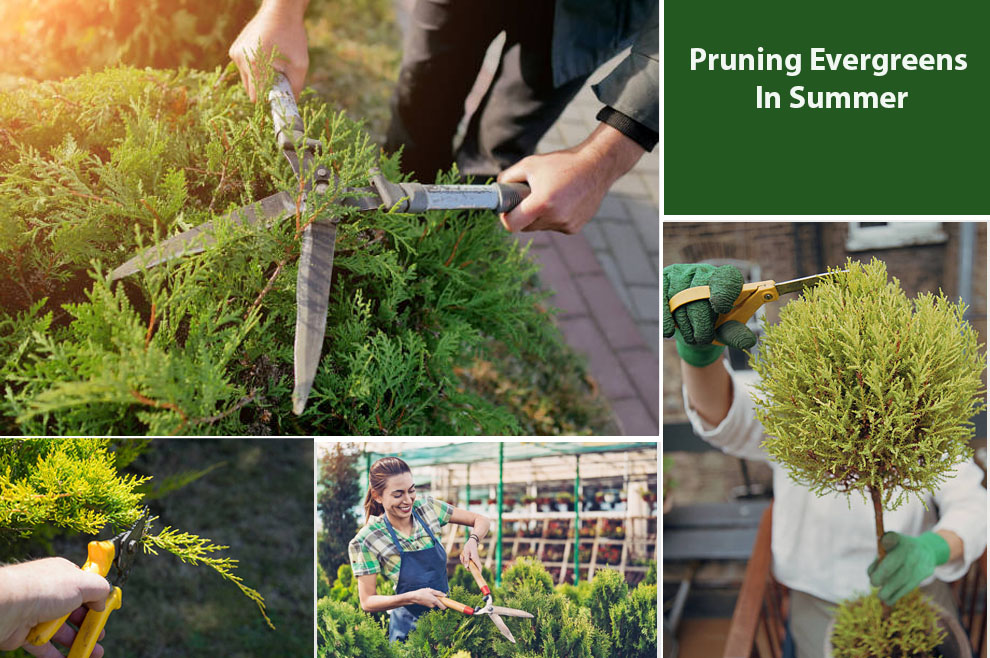
Evergreen bushes, with their year-round foliage, bring enduring beauty and greenery to landscapes across the globe.
These steadfast companions of gardens and yards provide not only aesthetic appeal but also serve essential functional roles, such as privacy screens and windbreaks.
However, to ensure that evergreen bushes remain healthy, vibrant, and an asset to your outdoor space, one crucial task stands out: pruning.
But, it is bound to get confused about when to prune them, can you trim evergreen bushes in the summer, winter, or fall? What’s the best to do?
Pruning evergreen bushes is more than just a horticultural chore; it is a delicate art that, when done correctly, can transform these woody stalwarts into stunning showcases of form and vitality.
Pruning evergreen trees and bushes involves removing dead or overgrown branches to improve aesthetics and health. Use sharp, clean tools, and make cuts at a 45-degree angle just above a healthy bud or branch.
Trim during the dormant season for most evergreens, and avoid cutting too much at once to prevent stress.
This article delves into the intricate process of pruning evergreen bushes, shedding light on why it is not merely an option but a necessity for their well-being and appearance.
Evergreen Bushes & Trees
Different types of evergreen trees and bushes, a vital component of landscaping, retain their lush foliage throughout the year, providing year-round greenery and structure. They offer privacy, wind protection, and aesthetic appeal.
Common varieties in the US include Boxwood, Arborvitae, and Rhododendron. These hardy plants form the backbone of many gardens, enhancing their beauty and functionality.
Pruning Evergreens – Is It Necessary?
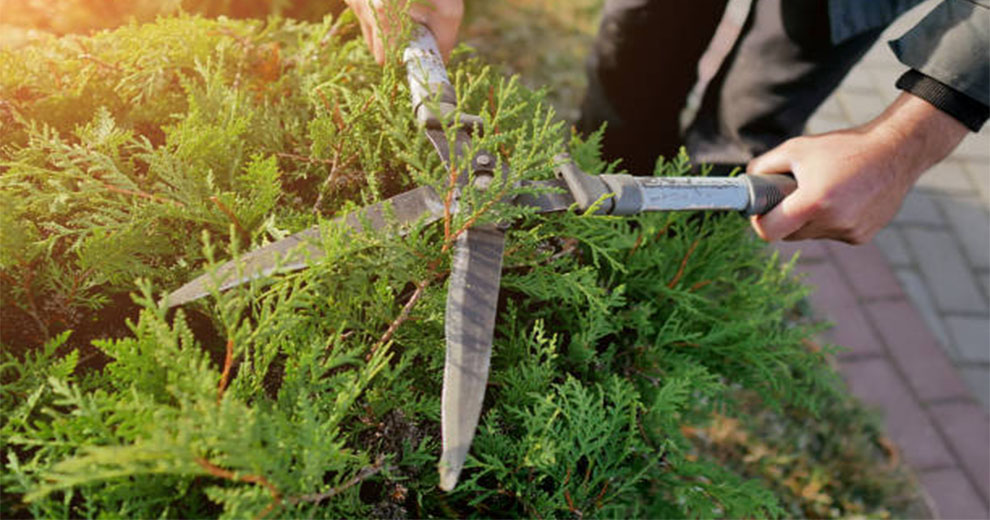
Before getting to pruning evergreens in summer. Let’s understand the importance of pruning.
Pruning is the deliberate trimming of plant branches to enhance their health and appearance.
Pruning plays a pivotal role in sculpting evergreen bushes, ensuring they maintain their desired shape and size. By selectively trimming branches, gardeners can create well-defined silhouettes, ensuring that the bushes fit seamlessly into their intended landscape design.
Pruning should be timed according to the season. In spring, it’s ideal for rejuvenating growth. Summer is suitable for corrective trimming. Fall prepares bushes for winter.
Winter pruning minimizes stress. Properly timed pruning aligns with the natural growth cycles of evergreens, optimizing their health and appearance.
Can You Trim Evergreen Trees In The Summer – Is It A Good Idea?
Though it is not ideal. But contrary to the common belief that pruning should be reserved for spring or fall, summer pruning can be a valuable practice. It challenges the misconception that these seasons are the only suitable times for this horticultural task.
Summer pruning offers distinct advantages in specific scenarios. It encourages branching, reduces excessive growth, and can enhance the aesthetics of evergreen bushes during the growing season.
This technique can be especially useful for maintaining desired shapes and controlling unruly growth.
Concerns about summer pruning often revolve around plant stress. While it’s true that pruning during hot weather can cause temporary stress, proper techniques and timing can mitigate this.
Adequate watering and avoiding pruning during heatwaves can help ensure the plant’s well-being during this season.
Benefits of Summer Pruning Evergreen Bushes
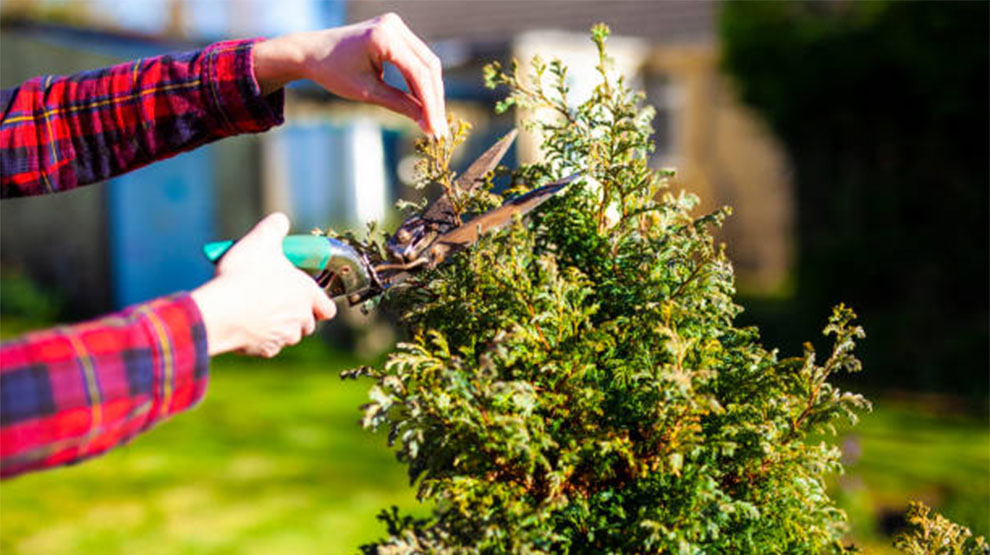
There are certain advantages to summer pruning evergreen trees and bushes:
1. Controlled Growth: Summer pruning allows you to manage the size and shape of evergreen bushes actively.
By selectively trimming branches during the growing season, you can prevent excessive growth and maintain a neat and desired appearance.
2. Reduced Disease Transmission: Removing dead or diseased branches in the summer helps reduce the risk of disease spread. Summer pruning minimizes the entry points for pathogens and pests, enhancing the overall health of the evergreens.
3. Improved Aesthetics: Pruning during the summer can result in immediate visual improvements. Overgrown or straggly bushes can be transformed into well-manicured specimens, enhancing the overall attractiveness of your landscape.
4. Encourages Branching: Summer pruning can stimulate lateral growth and branching. This encourages a denser, fuller appearance, making the bushes look more robust and appealing.
5. Enhanced Air Circulation: Properly pruned evergreens allow for better air circulation through the foliage. This can reduce the risk of fungal diseases and mold development, promoting a healthier environment for the plants.
6. Increased Flower and Fruit Production: For evergreen bushes that produce flowers or fruits, summer pruning can lead to improved bloom quality and fruit development.
By removing spent flowers or overgrown branches, you redirect the plant’s energy into producing new growth and reproductive structures.
7. Long-Term Maintenance: Regular summer pruning can help you keep evergreen bushes at a manageable size, reducing the need for more drastic pruning in the future. This can make maintenance easier and less time-consuming over the long term.
When NOT to Prune Evergreen Bushes or Trees in Summer
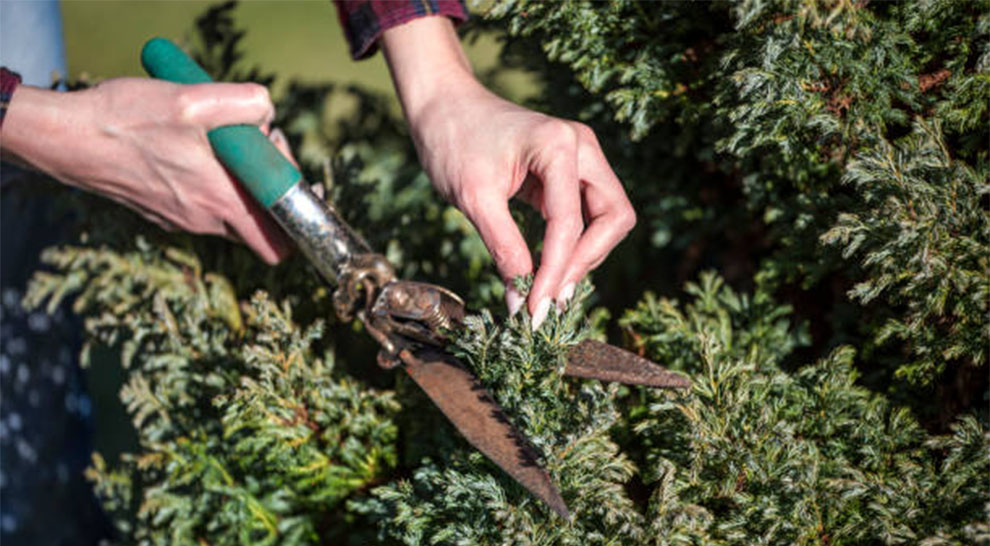
There are situations when you must avoid summer pruning at all costs. So, if your situation is anything close to the ones listed below, know that our answer to ‘Can you trim evergreen bushes in the summer’ – is a big NO!
A. Extreme Heatwaves
During periods of extreme heat, it’s best to avoid summer pruning. High temperatures and intense sunlight can stress plants even without the added stress of pruning.
Pruning during a heatwave can lead to excessive moisture loss through the open wounds, making the plant more vulnerable to damage.
B. Drought Conditions
In regions experiencing drought conditions, summer pruning should be minimized or postponed.
Pruning can reduce the foliage that provides shade and conserves moisture for the plant. During drought, it’s crucial to prioritize water conservation and plant health.
C. Late Summer
Towards the end of summer, it’s advisable to hold off on pruning. Plants are preparing for the winter months, and pruning too late can stimulate new growth.
In this case they might not have sufficient time to harden off before cold weather arrives, making it vulnerable to frost damage.
D. Stressed Plants
If your evergreen bushes or trees are already stressed due to factors like disease, pests, or recent transplanting, avoid summer pruning. Pruning can further stress weakened plants, making their recovery more challenging.
E. Flowering Evergreens
If you have evergreen bushes that flower in late summer or early fall, avoid pruning during this time, as you risk removing flower buds.
Instead, prune these bushes immediately after they finish flowering to maintain their appearance and promote future blooms.
F. Newly Planted Evergreens
Newly planted evergreens require time to establish their root systems.
It’s generally best to avoid summer pruning in the first year after planting to allow the plant to focus its energy on root development and acclimatization.
Step-by-Step Guide to Summer Pruning Evergreen Trees and Bushes
Summer pruning of evergreen trees and bushes can be a rewarding endeavor when done correctly. Follow this clear step-by-step guide to ensure you prune with precision and care:
1. Choose the Right Tools:
- Gather essential tools, including sharp bypass pruners, loppers for larger branches, and saws for thick branches.
- Ensure all tools are clean and well-maintained to prevent disease transmission.
2. Assess Your Goals:
- Determine your pruning objectives, whether it’s shaping, size control, or dead branch removal.
- Visualize the desired appearance before you start pruning.
3. Timing is Key:
- Plan your pruning for early to mid-summer when new growth has slowed, but the plant is still actively growing.
- Avoid late summer pruning to prevent stimulating new growth that may not harden off before winter.
4. Identify Dead or Diseased Branches:
- Start by inspecting the tree or bush for dead, diseased, or damaged branches.
- Remove these first to improve overall health.
5. Maintain Shape and Size:
- To maintain shape, selectively trim branches that extend beyond the desired outline.
- For size control, cut back branches to a lateral bud or branch junction, ensuring you don’t remove more than one-third of the canopy.
6. Make Clean Cuts:
- Use sharp, clean tools to make precise cuts.
- Make cuts at a slight angle just above a healthy bud or lateral branch, promoting new growth in the right direction.
7. Avoid Flush Cuts:
- Don’t make cuts too close to the trunk, as this can lead to slow healing and decay.
- Leave a small collar of bark at the base of the branch to aid in sealing the wound.
8. Step Back and Evaluate:
- Periodically step back to assess your progress and ensure you’re achieving your pruning goals.
- Adjust as needed to maintain a balanced appearance.
9. Safety Precautions:
- Wear protective gear, including gloves and safety glasses.
- Be cautious of falling branches and work on stable ground.
- Be mindful of electrical wires if pruning near utility lines.
10. Clean Up:
- Remove all pruned branches and debris from the area to prevent disease spread and maintain a tidy landscape.
Related Pruning Guides: Pruning Magnolia Trees | How to Prune Hellebores
Common Mistakes to Avoid While Pruning Evergreens in Summer
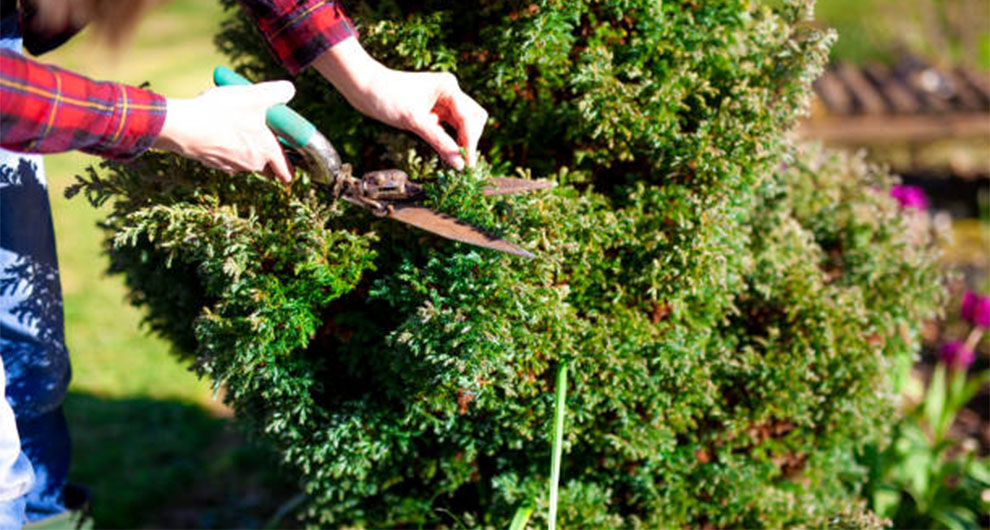
To ensure successful summer pruning, be aware of these common mistakes and their potential consequences:
1. Over-Pruning:
- Mistake: Removing too much foliage at once, leading to stress and reduced photosynthesis.
- Consequence: Weakened plants, and increased vulnerability to pests and diseases.
2. Pruning During Heatwaves:
- Mistake: Pruning during extreme heat can cause excessive moisture loss and stress.
- Consequence: Increased risk of plant damage or death.
3. Neglecting Tools:
- Mistake: Using dull or dirty tools.
- Consequence: Ragged cuts that heal slowly and potential disease transmission.
4. Incorrect Cutting Technique:
- Mistake: Making improper cuts, such as flush cuts or leaving stubs.
- Consequence: Slow healing, disease entry points, and unsightly appearance.
5. Neglecting Safety:
- Mistake: Pruning without safety gear or on unstable surfaces.
- Consequence: Personal injury or accidents, such as falling branches.
6. Pruning Flowering Evergreens at the Wrong Time:
- Mistake: Pruning after flowering in flowering evergreens.
- Consequence: Removal of potential flower buds for the next season.
By avoiding these common mistakes and following the step-by-step guide, you can achieve effective and safe summer pruning, enhancing the health and beauty of your evergreen trees and bushes.
